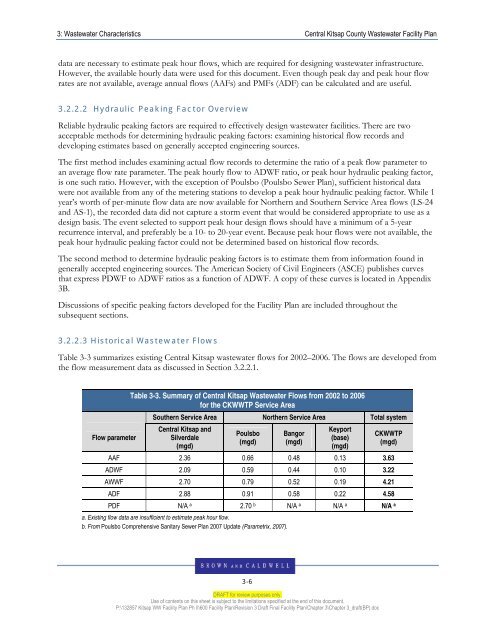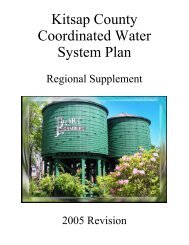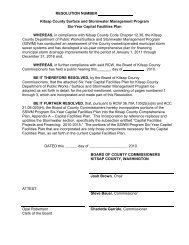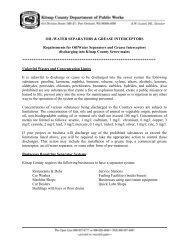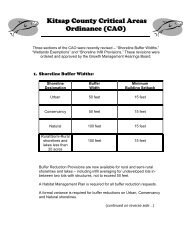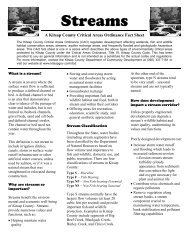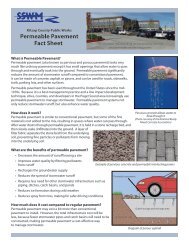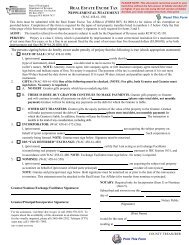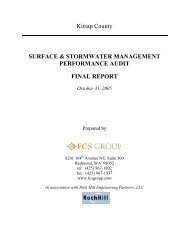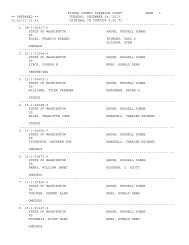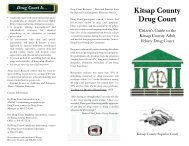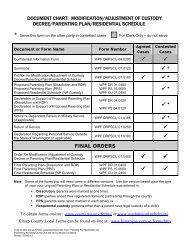CENTRAL KITSAP COUNTY WASTEWATER FACILITY PLAN ...
CENTRAL KITSAP COUNTY WASTEWATER FACILITY PLAN ...
CENTRAL KITSAP COUNTY WASTEWATER FACILITY PLAN ...
Create successful ePaper yourself
Turn your PDF publications into a flip-book with our unique Google optimized e-Paper software.
3: Wastewater Characteristics Central Kitsap County Wastewater Facility Plan<br />
data are necessary to estimate peak hour flows, which are required for designing wastewater infrastructure.<br />
However, the available hourly data were used for this document. Even though peak day and peak hour flow<br />
rates are not available, average annual flows (AAFs) and PMFs (ADF) can be calculated and are useful.<br />
3.2.2.2 Hydraulic Peaking Factor Overview<br />
Reliable hydraulic peaking factors are required to effectively design wastewater facilities. There are two<br />
acceptable methods for determining hydraulic peaking factors: examining historical flow records and<br />
developing estimates based on generally accepted engineering sources.<br />
The first method includes examining actual flow records to determine the ratio of a peak flow parameter to<br />
an average flow rate parameter. The peak hourly flow to ADWF ratio, or peak hour hydraulic peaking factor,<br />
is one such ratio. However, with the exception of Poulsbo (Poulsbo Sewer Plan), sufficient historical data<br />
were not available from any of the metering stations to develop a peak hour hydraulic peaking factor. While 1<br />
year’s worth of per-minute flow data are now available for Northern and Southern Service Area flows (LS-24<br />
and AS-1), the recorded data did not capture a storm event that would be considered appropriate to use as a<br />
design basis. The event selected to support peak hour design flows should have a minimum of a 5-year<br />
recurrence interval, and preferably be a 10- to 20-year event. Because peak hour flows were not available, the<br />
peak hour hydraulic peaking factor could not be determined based on historical flow records.<br />
The second method to determine hydraulic peaking factors is to estimate them from information found in<br />
generally accepted engineering sources. The American Society of Civil Engineers (ASCE) publishes curves<br />
that express PDWF to ADWF ratios as a function of ADWF. A copy of these curves is located in Appendix<br />
3B.<br />
Discussions of specific peaking factors developed for the Facility Plan are included throughout the<br />
subsequent sections.<br />
3.2.2.3 Historical Wastewater Flows<br />
Table 3-3 summarizes existing Central Kitsap wastewater flows for 2002–2006. The flows are developed from<br />
the flow measurement data as discussed in Section 3.2.2.1.<br />
Flow parameter<br />
Table 3-3. Summary of Central Kitsap Wastewater Flows from 2002 to 2006<br />
for the CKWWTP Service Area<br />
Southern Service Area Northern Service Area Total system<br />
Central Kitsap and<br />
Silverdale<br />
(mgd)<br />
Poulsbo<br />
(mgd)<br />
Bangor<br />
(mgd)<br />
Keyport<br />
(base)<br />
(mgd)<br />
CKWWTP<br />
(mgd)<br />
AAF 2.36 0.66 0.48 0.13 3.63<br />
ADWF 2.09 0.59 0.44 0.10 3.22<br />
AWWF 2.70 0.79 0.52 0.19 4.21<br />
ADF 2.88 0.91 0.58 0.22 4.58<br />
PDF N/A a 2.70 b N/A a N/A a N/A a<br />
a. Existing flow data are insufficient to estimate peak hour flow.<br />
b. From Poulsbo Comprehensive Sanitary Sewer Plan 2007 Update (Parametrix, 2007).<br />
3-6<br />
DRAFT for review purposes only.<br />
Use of contents on this sheet is subject to the limitations specified at the end of this document.<br />
P:\132857 Kitsap WW Facility Plan Ph II\600 Facility Plan\Revision 3 Draft Final Facility Plan\Chapter 3\Chapter 3_draft(BP).doc


